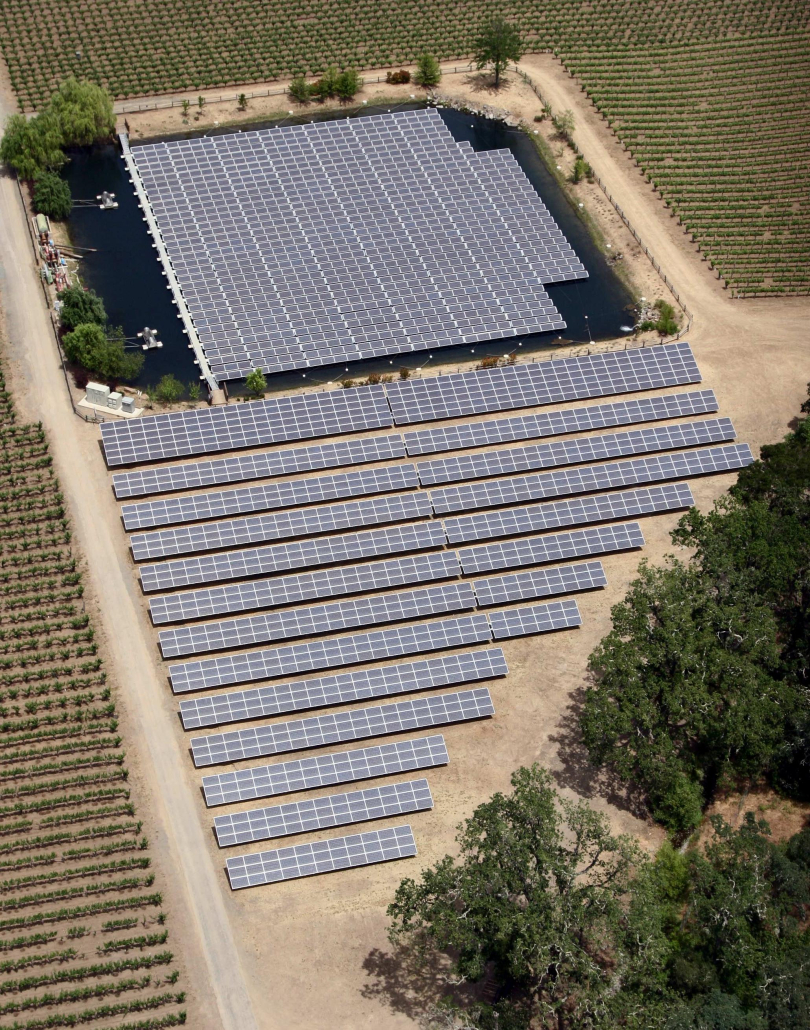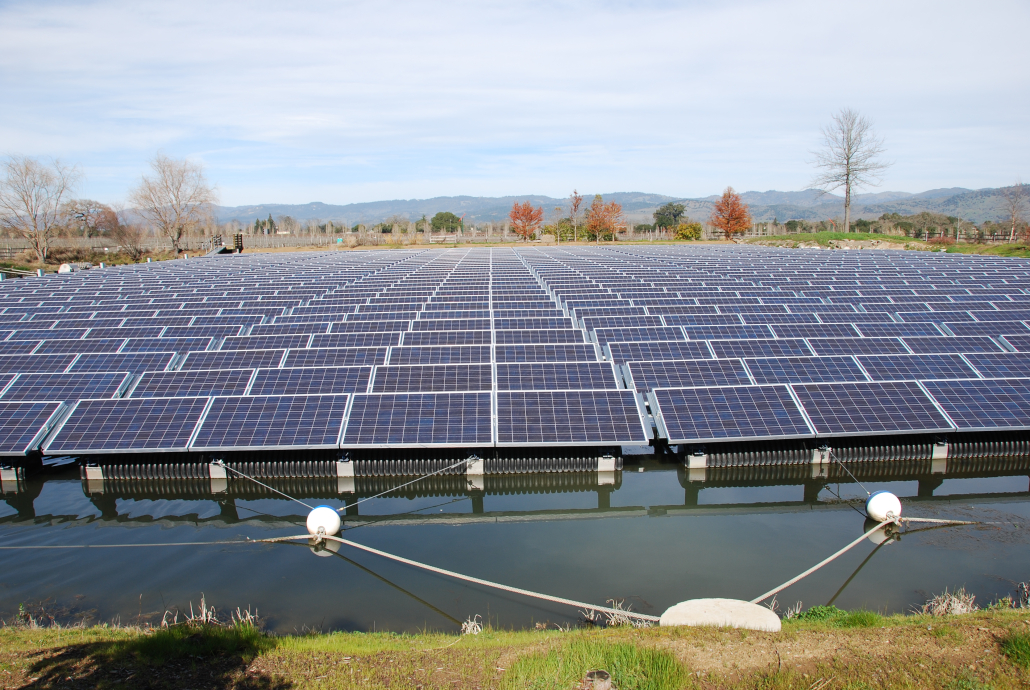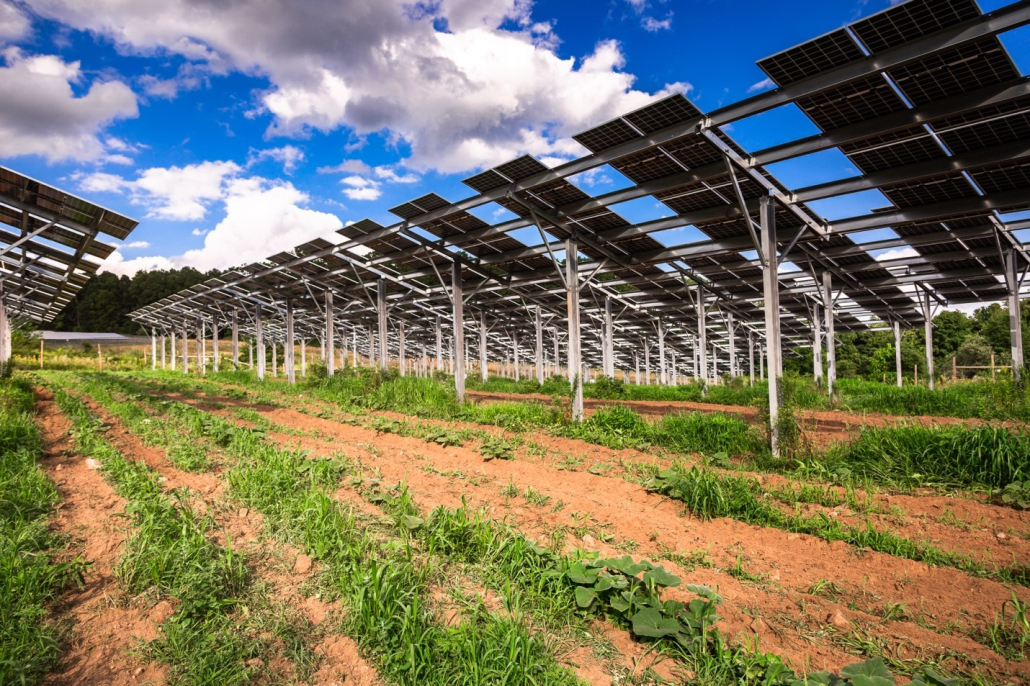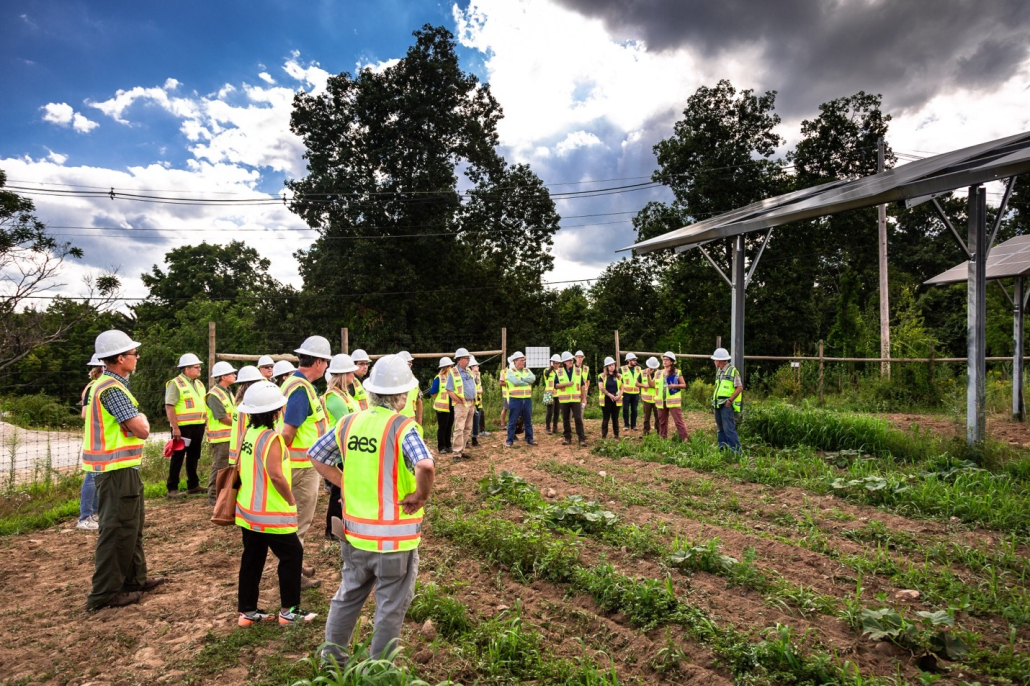Researchers in this study used experimental panels to simulate the effects of solar development on microhabitats and annual plant communities present on gravelly bajada and caliche pan habitat, two common habitat types in California’s Mojave Desert. They evaluated soils and microclimatic conditions and measured community response under panels and in the open for seven years. The study’s results demonstrate that the ecological consequences of solar development can vary over space and time and suggest that a nuanced approach will be needed to predict impacts across desert landforms differing in physical characteristics.
Tag Archive for: Agrivoltaics

By Anna Richmond-Mueller, NCAT Energy Analyst
At Far Niente Winery, respecting the land and all it provides is just second nature. Since 1979, their winemakers have been coaxing award-winning wines out of the grapes grown on their Napa Valley estate, but in 2005 began embracing their role as environmental stewards through their sustainability practices related to farming, winemaking, and renewable energy generation. Located on the Martin Stelling Vineyard in Oakville, Far Niente’s floatovoltaic system is at the forefront of the winery’s commitment to those sustainable practices and ethical winemaking.
When Far Niente decided to go solar, they faced challenges both unique and common to the agricultural world. Where many businesses may have chosen to place panels on the roof of their buildings, Far Niente’s old stone winery building is on the National Register of Historic Places, making it impossible to do so without violating regulations. Installing ground-mounted panels immediately around the heritage building was not an appealing solution either. After doing the math and realizing they would need to install over 2,000 panels to hit their energy production goal, they were faced with a tough choice: remove established cabernet sauvignon vines or get creative and take a risk. “Taking two acres out of cabernet production really hurts,” says winemaker Greg Allen. “By looking to the pond, it allowed us to maximize how many grape vines we were able to keep and still meet our goal.” These challenges ultimately culminated in the decision to build the world’s first grid-connected floating solar array, despite the lack of real-world success stories of floatovoltaic arrays at the time.
Developed by Thompson Technology Industries and installed by SPG Solar, the ambitious project went live in April 2008. A total of 1,000 Sharp 208 polysilicon panels were installed over the vineyard’s pond, covering just shy of a full acre. The panels rest atop pontoons anchored to the pond’s banks via marine-grade cabling attached to concrete columns. This setup allows the pontoons to rise and fall with changing water levels throughout the year. Rounding out the vineyard’s solar system are 1,300 ground-mounted panels adjacent to the pond. The system was originally installed with a 500-kilowatt central inverter, but that was replaced after 10 years with 12 SolarEdge string inverters. Together at peak output, the arrays generate roughly 407 kilowatts total with about 177 kilowatts coming from the floatovoltaic system alone.

Unsurprisingly, building such a system comes with a substantial financial commitment. The project’s total cost was $4.2 million upon completion, with an estimated payback period of 12 to 15 years. Fortunately, the net cost for Far Niente was significantly less, thanks to a $2.80/kW self-generation cash rebate from Pacific Gas & Electric, as well as a 30% federal tax incentive and accelerated depreciation tax benefit. The winery worked with Banc of America Leasing and Capital on a seven- year lease as well, which included a buyout option that would allow them to be the sole owners of the system. Far Niente did opt to purchase the array at the end of the seven years, and reports that the system paid for itself at around year 14 of operation.
With all the energy generated by the system, the winery is able to cover about 80% of its annual energy requirements, but that is far from the only benefit. The floatovoltaic array saves almost a full acre of viable land from being sacrificed for additional ground-mounted panels. Since this part of the vineyard is foundational to the winery’s cabernet sauvignon program, all that preserved space equates to thousands of dollars of bottled cabernet sauvignon revenue saved each year.
Additionally, there’s reason to believe that the panels’ positioning on top of the pond leads to increased efficiency when compared to the ground-mounted panels. Greg Allen has taken the surface temperature of the panels and found that those on the floating array can measure up to 5 degrees Fahrenheit cooler than their land-based counterparts. Because photoelectric conversion improves in cooler environments, keeping the solar panels at a lower temperature will increase the energy production efficiency when compared to the warmer panels on land.
A further boon to resource management is the array’s potential to reduce evaporation rates — a crucial win for a vineyard operating in an area seeing increasingly higher temperatures and more frequent drought conditions. While Greg notes that there is no completed study yet, he says, “In my mind, I think that the panels decrease the amount of evaporative loss from the pond.” He adds that it is difficult for the winery to quantify the potential amount of water saved, since there are systems both pulling water from and pushing water to the pond at various times. Currently, the pond serves the winery in several capacities, including as a fire- and frost-protection system, irrigation source, and as the recipient of all process wastewater from the winemaking facility. Three wells intermittently feed the pond, as well. Greg states that there is an ongoing research partnership between the winery and University of California Davis that will hopefully shed light on the shading and water conservation benefits, as well as the ecological impacts of the array.
When reflecting on the challenges the project presented, Greg says “Interconnection [to the grid] was a big one.” In order to meet their energy production goals, the entire system needed a 500-kilowatt inverter. The winery hit a roadblock with the project when they realized the main service transformer for the winery was only half that size. Far Niente’s utility provider requires that the main service transformer must be able to accommodate 100% of the energy produced by a solar system. “That spawned a massive project of its own,” Greg says, since the winery then had to replace their transformer to match the power rating of the inverter before they could bring the array online.
As the system approaches 15 years of use, they are noticing more individual panel failures. Greg says that the panels installed in 2007 are no longer commercially available to replace the failed panels, but there is a silver lining. He estimates around five more years of operation with their current set up, and then the winery could begin to look at the possibility of a major system overhaul. Over a decade of research and development has greatly increased the efficiency of today’s panels, providing the possibility of cutting their solar array footprint in half while maintaining the amount of energy produced on-site. “We could regain substantial amounts of vineyards,” he says. Should the winery choose to overhaul their entire system in such a way, the future revenue from the potentially recovered vineyard space could fund the cost of the improved system.

Looking back, Greg says a big challenge has been on the operations and maintenance side of owning the arrays. “Our main job is making and selling wine, and suddenly we’re put in the position of having to – on a daily basis – verify that the system is functioning and then initiate troubleshooting” when it’s needed. He points out that in the beginning, no one at Far Niente was an expert at what essentially became running a small power plant, but they had to develop that expertise in order to keep the system operating. With the possibility of a new system installation on the horizon, Greg speculates that partnering with a third party on a power purchase agreement could be an ideal solution for Far Niente. A power purchase agreement is an arrangement that allows a solar developer to install, operate, and own a system on a customer’s land. The customer is then able to purchase the electricity generated by the system directly from the developer, often at reduced rates. “It means that we would have on-site generation of renewable energy that we use,” he says, “and we would rely on the experts to maintain the system while we focus on growing grapes and making phenomenal wine.”
No decisions have been made yet as to whether Far Niente will pursue upgrading their system or move towards a power purchase agreement. Regardless of what path the winery will take in the coming years, Greg says they are really pleased with their decision to pursue onsite renewable energy generation and the overall performance of the solar arrays over the years. In particular, the winery’s ownership and staff have enjoyed being pioneers in the field of floatovoltaics. Far Niente’s years of renewable energy generation serve as an excellent example of how solar energy production can support a company’s efforts to implement sustainable measures while existing in harmony with agricultural operations.
This study presents data for a techno-economic price-performance ratio calculation retrieved from an inter- and transdisciplinary agriphotovoltaic case study in Germany.
The Maine Department of Agriculture, Conservation, and Forestry presents this technical guide regarding the siting of utility-scale solar projects with consideration for valuable agricultural land, forest resources, and rare or unique natural areas. The guide is intended to provide practical information for those considering solar development on their property, as well as planning important preconstruction, construction, and post-construction/decommissioning activities.
This paper is an analysis of three different agrivoltaic configurations: static with optimal tilt, vertically-mounted bifacial, and single-axis horizontal tracking. A model is also developed to calculate the shadowing losses on the PV panels along with the reduced solar irradiation reaching the area under them for different PV capacity densities.
Below is a compressed version of the article – click here to view the original version.
This article posits that in order to optimize agrivoltaic systems for crop growth, energy pathways must be characterized. While solar panels shade crops, they also emit longwave radiation and partially block the ground from downwelling longwave radiation. The authors suggest that a deeper understanding of the spatial variation in incoming energy would enable controlled allocation of energy in the design of agrivoltaic systems. This paper also presents a model to quantify the downwelling longwave energy at the ground surface in an agrivoltaic array and demonstrates that longwave energy should not be neglected when considering a full energy balance on the soil under solar panels.
When installing photovoltaic panels on agricultural land, one of the most important aspects to consider are the effects of the shadows of the panels on the ground. This study presents a valid methodology to estimate the distribution of solar irradiance in agrivoltaic installations as a function of the photovoltaic installation geometry and the levels of diffuse and direct solar irradiance incident on the crop land.
This PhD dissertation addresses four primary questions: 1.) To what extent is plant-available radiation reduced by solar panels of a photovoltaic system? 2.) How does this effect parameters of aerial and soil climate? 3.) How do the cultivated crops respond to the altered cropping conditions with regard to plant growth and development? 4.) What consequences does this have regarding the yields and the chemical composition of the investigated crop-species? A field experiment in which grass clover, potatoes, celery, and winter wheat were planted under a photovoltaic facility in Southwest Germany was conducted to answer these questions.
This guide, developed in Germany by Fraunhofer, provides information on the potential of agrivoltaics, including the latest technologies and regulatory frameworks in this area. It also offers practical tips on how agrivoltaics can be used by farmers, municipalities and companies.
By Stephanie Hince, AES
Although Grafton, Massachusetts, is just an hour west of Boston, life there is very different. Grafton is a friendly country town with a lovely historical feel. It has been a farming community for centuries, where thriving cotton, grist, and paper mills once dotted the landscape.
Whereas the Quinsigamond River once powered numerous mills, a newly constructed solar farm owned by AES is incorporating two Grafton traditions: clean energy and agricultural production. Let’s explore how our solar project brings together key stakeholders to help protect farmland in Grafton and beyond.
Grafton Solar’s On-site Agricultural Production
This solar installation is located on Knowlton Farm, a family farm operating for over 150 years. Instead of merely leasing fallow farmland for the project, the solar farm was designed with on-site agricultural production and research in mind from the start.
Grafton Solar is a 2-megawatt community solar farm with a 1.4-megawatt battery energy storage system. Many stakeholders have come together with a shared vision of clean energy, food production, and learning, which is making this endeavor a success.
Our current and prospective project partners include the U.S. Department of Energy, Massachusetts Department of Energy Resources, Massachusetts Department of Agricultural Resources, UMass Amherst, American Farmland Trust, and Cornell University. In December 2020, AES acquired the Grafton Solar project from BlueWave.
What Made This Solar Farm Unique from Day 1
An agricultural plan was created early in the design phase as a collaboration between Paul Knowlton, a fifth-generation farmer and current operator of Knowlton Farms, Iain Ward of Solar Agricultural Services, and BlueWave Solar. Today, that plan has come to fruition. With a keen eye, passersby will notice something very different at our project site.
Borrego, the construction contractor, elevated the solar modules to a height of 8 to 14 feet and created large inter-row spacing to allow cattle grazing and access for farm equipment. The agricultural integration component of the project began last May with the planting of squash and lettuce, as well as cattle grazing.
There is still much to be learned. Solar developers and farmers need a greater understanding of how to make widespread use of agrivoltaics cost-effective and practical. Thus, Grafton Solar provides opportunities to advance its application on other project sites and by other solar developers across the U.S.

Grafton Solar is Now a Living Laboratory
We intentionally reserved a section of the project area for new and existing research partnerships – Grafton Solar is an official hub of activity for learning about agrivoltaics. Research partners, UMass Amherst and the American Farmland Trust, are working to establish site trials to assess crop productivity, soil health, and micro-climatic conditions, thanks to a grant from the U.S. Department of Energy Solar Energy Technology Office (SETO). Once available, research information will be made publicly available so that others in the solar and agricultural industries can learn and benefit from their findings.

Solar Incentives Helped Make This Innovative Project Possible
In Massachusetts, revenue for solar projects is provided through the SMART program, which starts with a fixed compensation rate for projects. A project can obtain different adders based on project attributes, which increases the rate and therefore the benefits to the project developer and landowner. Some of these adders include making a project a community solar farm, adding battery storage, or having a dual-use agricultural component. Grafton Solar does all three.
Community solar projects expand access to renewable energy and allow subscribers like households, businesses, educational institutions, municipalities, and others to experience the same benefits of solar power without having to install a solar array on their own property. Battery storage helps to mitigate the intermittent nature of solar energy by storing solar energy when production is high and electricity demand is low and promotes reliable, carbon-free power by making solar energy available when utility companies need it most. Thus, it reduces the need to use more polluting power plants when power demand is high.
Grafton Solar is built around the community solar model, incorporates battery storage, and is supporting a legacy of agricultural production at Knowlton Farm – a win-win-win. By leveraging Massachusetts’ innovative state-level solar incentives (which includes the only rate-adder for agrivoltaics in the U.S.), Grafton Solar is delivering multiple co-benefits to the community and showcasing that solar projects can do much more than produce power on site.
Protecting Farmland When Developing Solar Energy Projects
Grafton Solar is AES’ first agrivoltaic site in the Northeast and is consistent with our vision to provide the smarter, greener energy solutions the world needs. According to a report by the American Farmland Trust, the U.S. lost or compromised 2,000 acres of farmland and ranchland every day from 2001 to 2016.
If this trend continues, an area nearly the size of South Carolina will be lost between 2016 and 2040, which could be detrimental to food security. Many farmers across the U.S., like Paul Knowlton, are looking for new revenue streams and ways to keep family farms operating for future generations. In addition to producing food, family farms are also about preserving a way of life.
At AES, we understand the importance of protecting farmland when integrating renewable energy projects into the landscape. Solar energy development and farm viability can go hand-in-hand when taking a thoughtful, dual-use approach.
Using Partnerships to Maximize Opportunities
We understand the importance of land and are actively working to create synergies between renewable energy development and agricultural land use. In addition to successfully co-locating crop growth and grazing at Grafton Solar, we have implemented active sheep grazing on thousands of acres of land at utility-scale solar sites, and we are participating in research partnerships in various regions across the U.S. to better understand how we can harvest clean energy and food from the same land.
We know that the success of our company is only as strong as the partnerships within the communities where we operate, so we develop, build, and manage projects that maximize value to a variety of stakeholders. Ultimately, we need both clean energy and productive farmland, not just one or the other.
Grafton Solar provides an excellent opportunity to collaborate with the research community and the Knowlton family to further our understanding of how to make agrivoltaics practical and more widespread. The project symbolizes preserving a way of life that spans many generations while embracing innovative clean energy technologies that promote food security, reliable energy, and a cleaner environment.
